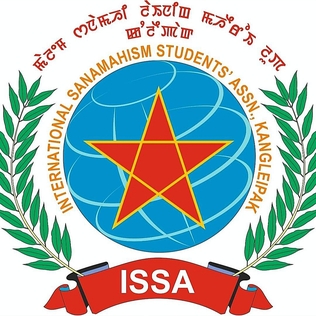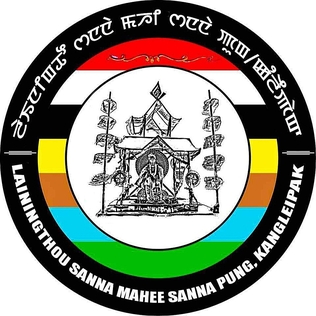
The Meitei people, Meetei people, or Manipuri people is an ethnic group native to Manipur. They form the largest and dominant ethnic group of Manipur in Northeast India. They speak Meitei language, one of the 22 official languages of the Indian Republic and the sole official language of Government of Manipur. The Meiteis primarily settled in the Imphal Valley region in modern-day Manipur, though a sizeable population has settled in the other Indian states of Assam, Tripura, Nagaland, Meghalaya, and Mizoram. There is also a notable presence of Meitei people in the neighbouring countries of Myanmar and Bangladesh. The Meitei ethnic group represents about 53% of Manipur's population.

Sanamahism, Meiteism, or Lainingthouism is an ethnic religion of the Meitei people of Kangleipak in Northeast India. It is a polytheistic religion and is named after God Lainingthou Sanamahi, one of the most important deities of the Meitei faith. Sanamahi is the eldest son of the supreme god Yaibirel Sidaba and the supreme goddess Leimarel Sidabi. Traditionally every Meitei household, irrespective of the religion, worships Sanamahi and Leimarel Sidabi. The importance of Sanamahi in the religion is also emphasized in the name itself which means Liquid Gold. Sanamahism does not have a religious head but has a body, Maru Loishang that oversees the main religious activities and govern all affairs pertaining to the religion including conducts of priest and priestess. The Maru Loishang also acts a court for religious disputes. There are three main departments under the Pandit Loishang, namely, the Amaiba Loishang, the Pena Asheiba Loishang and the Amaibi Loishang. These departments have existed since the reign of King Meidingu Hongnemyoi Khunjao Naothingkhong of Manipur in 662 AD.

Pakhangba is a primordial deity, often represented in the form of a Meitei dragon, in Meitei mythology and religion. He is depicted in the heraldry of Manipur kingdom, which originated in paphal, mythical illustrations of the deity in the traditional beliefs of Sanamahism in Manipur. Among the Meiteis, it is believed that the ancestor of one of the clans manifested himself as the Pakhangba.
Sanamahi Temple or Sanamahi Sanglen is a temple of Lainingthou Sanamahi, the supreme deity of Sanamahism. It is located in the Sanakhwa Yaima Kollup near Kangla Palace in Imphal West district of Manipur, India. It is one of the oldest temples in Asia. However, it is often confused with the Sanamahi Kiyong Temple, situated in the hilltop of the Nongmaiching Hill of Imphal East district of Manipur. It is one of the largest Kanglei temples in the state.
Laininthou Sanamahee is the Supreme Guardian God of mankind and the supreme deity of the household in Meetei religion and mythology. He originated from the ancient kingdom of Kangleipak (Manipur). He is regarded as the most popular and significant divinity of Sanamahism. He is the brother of Pakhangba and Nongshaba. He is the eldest son of Creator God Saalailel Sitapa and Leimalel Sitapee, the protector of the Universe in Meetei mythology and philosophy and Mother Earth goddess Leimarel Sidabi.

Leimarel Sidabi or Leimalel Sitapi is a goddess in Meitei mythology and the religion of Ancient Kangleipak. She is the highest female divinity in the Meitei pantheon. She is the goddess of earth, of nature and the household. She is revered as the mother of every living being in the universe.

Nongshaba, also spelled as Nongsaba, is a Lion God in Meitei religion (Sanamahism) and mythology. He is also regarded as a king of the gods. He is credited with producing light in the primordial universe and is regarded as the maker of the sun. He is worshipped by the people of both the Ningthouja clans as well as the Moirang clans. God Nongshaba was worshipped by the people of Moirang clan as a lineage deity and regarded as the father of God Thangching (Thangjing). He is the greatest of the Umang Lais in Ancient Kangleipak but he made his only son Thangching (Thangjing) the chief deity of Moirang.
The Hiyangthang Lairembi Temple is an ancient temple of Goddess Hiyangthang Lairembi of Meitei religion (Sanamahism). The sacred building is situated on the hilltop of Heibok Ching in the Hiyangthang, Manipur. Thousands of devotees thronged at the holy site during the festival time of Lai Haraoba of Sanamahism as well as Durga Puja of Hinduism.
Thangjing Temple, also known as Ibudhou Thangjing Temple or Ebudhou Thangjing Temple, is a grand ancient temple dedicated to God Thangjing, the ancient national deity of ancient Moirang. The best time to visit the temple is from May to July during the onset of the traditional music and dance religious festival of Lai Haraoba. It attracts many tourists every year, including historians and archaeologists.

Irai Leima or Ireima is a goddess in Meitei mythology and religion (Sanamahism) of Ancient Kangleipak. She is the goddess and the divine female personification of water and aquatic life. She is also considered to be the incharge of the diseases.

Yumjao Leima or Yumjao Lairembi or Yumjao Lairemma is the mother goddess of house, household, royalty, rule and power in Meitei mythology and religion. She is designated as the all time ruling Queen Mother. Legend says she assumes a human form in white clothes and blesses kings. She is one of the divine incarnations of Leimarel Sidabi.
The Nongmaiching Ching, also known as the Selloi Langmai Ching, is a mountain in Imphal Valley, Manipur. It has an altitude of around 5,133 feet (1,565 m). It is a holy pilgrimage site for the Meitei people. In Meitei mythology and religion (Sanamahism), it is a sacred mountain and the abode of God Nongpok Ningthou and Goddess Panthoibi. In Meitei folklore, the Nongmaiching is described as the hill that produces "the seven days of a week".

The Meitei: Lainingthou Sanamahi Kiyong, lit. 'Lainingthou Sanamahi Shrine'), officially known as the Meitei: Laiyingthou Sanamahi Kiyong, lit. 'Laiyingthou Sanamahi Shrine'), is a temple of God Lainingthou Sanamahi of Meitei religion (Sanamahism), built on the Nongmaiching mountain in the Imphal East district of Kangleipak. It is a center of the Sanamahism followers in Manipur. It is the central body of the "Sanamahi Lainingkol" at Chingoi Maru Langmaiching (Nongmaiching).

The International Sanamahism Students' Association (ISSA) (Meitei: Malem Sanamahi Laining Maheiroi Lup), also called the International Sanamahism Students' Association, Kangleipak (Meitei: Malem Sanamahi Laining Maheiroi Lup, Kangleipak), is an international non-governmental organization of students of Sanamahism (traditional Meitei religion). It gives its services to the conservation and the upraising of the practices of Sanamahism in the society. It also draws the attention to the government of Manipur state to take up essential steps to protect Sanamahism from getting extinct.

The Lainingthou Sanna Mahee Sanna Pung, Kangleipak, also known as the Lainingthou Sanamahi Sanapung (LSSP), is a non-governmental organization of the followers of the Sanamahism, dedicated to God Lainingthou Sanamahi and other ancient Meitei deities of Kangleipak.

The South East Asia Cultural Organisation (SEACO) is an international cultural organization that works for the development of the Meitei culture of Kangleipak (Meitei for 'Manipur'). It aims to preserve the unique history, culture, identity, and religion of Manipur. It also advocates to take "extra caution about the issue of preservation of the cultural identity of the Indigenous people in the wake of the present globalization".

Meitei festivals are an integral part of the cultural heritage of the Meitei people, an ethnic group native to the Indian state of Manipur. The festivals often celebrate events from Ancient Manipur and often coinciding with seasonal changes. These festivals reflect the unique customs and traditions of the Meitei community, and are celebrated with great enthusiasm and zeal. There are various festivals celebrated throughout the year, each with its own significance and rituals.

Many Chings play significant role in different elements of Meitei culture, including but not limited to Meitei folklore, Meitei folktales, Meitei literature, Meitei mythology and Meitei religion (Sanamahism) of Kangleipak.












